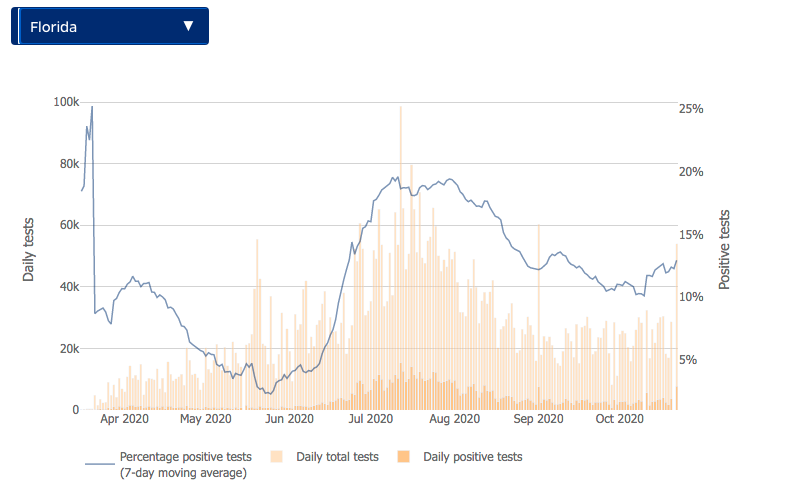During Thursday’s second (and thankfully last) presidential debate, incumbent republican nominee Donald Trump made a shocking claim to those of us who follow data.
“There was a spike in Florida, and it’s now gone,” Trump said. “There was a very big spike in Texas; it’s now gone. There was a very big spike in Arizona; it’s now gone.”

It relates to something Trump has advocated since the beginning of the pandemic, and it’s echoed by his personal advisor on the pandemic, Fox “News” personality and neuroradiologist Scott Atlas: If you test less, you identify fewer cases. Identifying fewer cases means that you can claim victory.
The flawed logic is obvious: not identifying the cases doesn’t mean the cases exist. It just means they’re not treated. Just like you don’t need a positive pregnancy test to actually be pregnant, you don’t need a positive COVID test to have COVID.
Florida, for example, has cut testing in half since July. Positive rates, however, did not follow a similar path: instead of positivity rates dropping to single digits, more than 12% of tests come back positive. In fact, Florida hasn’t has positivity rates in the single digits since June.
Taking a different route, Texas has chosen a different formula to appear to “flatten the curve.” They sporadically results bulk number of tests: Every four or five days, they’ll report more than 70,000 test results, interspersed with days of reporting fewer than 35,000. A day of 18,500 tests results has 1,400 positive results, an 8% positivity rate. That will be smoothed out by days of 118,000 tests that report only 3,800 positive cases, or a 3% rate.
That’s designed to lower the 7-day running average of cases. Selectively reporting, as Texas is doing, allows Texas manipulate the averages. Texas has done this to drop their publicly announced 7-day running average from a 24% positivity rate to 8.3%, even as they average 60,000 tests a day. The number of active cases in Texas continues to rise, but according to Trump, they’ve “rounded the turn.”
Arizona is the outlier in Trump’s statement. While Arizona had a huge spike of cases in July, it’s been relatively flat since. The recent spike Trump may be referring to is still rising, but as a “soft” slope, not nearly as dramatic as Texas and Florida. It’s testing level has been consistent over the last month, showing that the data is sound in both the number of cases and case positivity rate.
States like Pennsylvania, South Dakota and Wisconsin, who have had consistent numbers of tests, have seen dramatic spikes in positivity rates, indicating that more testing is needed to accurately gauge the spread of the virus.
Why are these data points “life-threatening”? Unless you have a consistent percentage of people getting tested in all states, you have no true gauge of what the infection rate is, and an intentionally skewed testing pattern means you’re not putting enough resources to stop the spread. In fact, it means that you don’t even know what the spread of the virus is in your state.
The one thing we all understand: fewer tests does not mean fewer cases. It just means we’ll be unprepared for a rising number of new cases that we’re expecting.